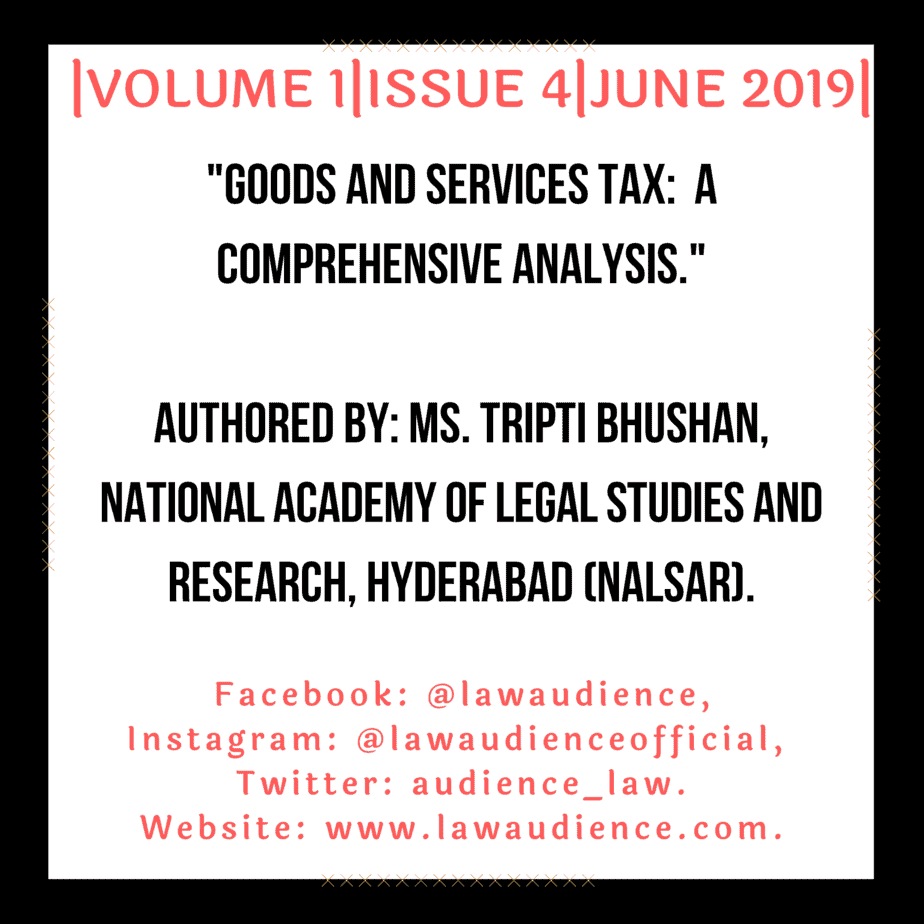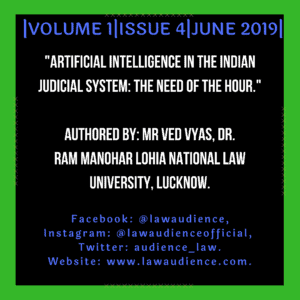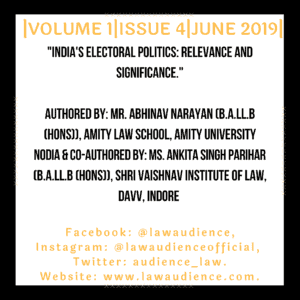Authored By: Ms. Tripti Bhushan, National Academy of Legal Studies and Research, Hyderabad (Nalsar).
CHAPTER 1: INTRODUCTION:
Goods and Services Tax (GST) can be considered to be one of the most noteworthy reforms with respect to the indirect taxes in India. The Amendment leading to this watershed development was the Goods and Services Tax Constitutional Amendment, i.e., the Hundred and First Amendment, which came into the picture in 2016 after ratification performed by a number of states above the required majority. GST is aimed to be a tax of indirect nature whose qualification is to absorb and include the various existing state and central taxes which include service tax, entry tax and value-added taxes. The underlying reasoning to introduce GST was to curb the menace around the issue of repetitive taxation or double taxation and this could be approached by clubbing the several types of central and state taxes into one individual tax which then would be imposed on the people in a holistic manner. This system of taxation is one which takes into consideration the entire market of the country. The system of GST is supposed to address problems in the system of taxation and to help create a tax regime which is more balanced and fit than the one which prevailed before GST which often led to situations of economic jumble created due to the presence of too many taxes, etc.[1]
If one has to analyse GST in terms of how it will affect the consumers in the market, it comes off as a relief and gives them a benefit of decreased taxes and rates on goods, which usually is near about 25-30 per cent. GST will also render the goods and the products made in India more desirable and competitive in domestic as well as international markets. This would, in a result, lead to a positive spurt in the economic growth of the country. Also, the way the tax is formulated it gives itself a character of transparency and power of self-policing which means that the tax will be simpler to administer comparatively.[2]
CHAPTER 2: GST: KEY FEATURES:
The Amendments to GST came out on July 1st of 2017[3] in India which constitutes to be one of the most significant tax reforms after the country’s independence. The taxation policy has the following features:
- All the forms of indirect taxes imposed by both the Centre and the States respectively will be replaced and subsumed by this tax, the only exception been given to customs duty. For levying and the collection of taxes, the jurisdiction at both levels is concurrent.
- The original principle of taxation based on the origin has been replaced in this new policy to a principle of taxation based on the destination of consumption.
- GST consists of three levels namely, (C)GST i.e. the tax levied by Central Government. (S)GST i.e. the tax levied by State Government and the (I)GST knows as the integrated GST which is to be collected and levied by Central Government after supply and rendering of goods, services in order to prevent disordering and disruption of credit chain.
- Both the CGST and the SGST will simultaneously be levied on each and every transaction related to supply except for the goods and services which are exempted.
- A provision allows for compensation to the States which might lose out on revenue due to GST and the same will be given for over a period of five years.
- The Central Level Taxes (CLT) comprise of excise duties (central as well as additional), Service tax, Countervailing duty, special additional customs duty, etc.
- The State Level Taxes (SLT) comprise of Sales tax or State VAT, all forms of Entry taxes, Purchase tax, Luxury tax, Entertainment tax, taxes on lottery and advertisements, etc.
- The slabs decided are four in numbers which are at 5%, 12%, 18%, and 28% along with a cess additionally charged for sin luxuries and goods like tobacco, pan masala, sodas and aerated drinks.
- Services will also be taxed under the new GST regime with two exceptions granted to healthcare and education which are regarded as essential services.
- An interesting feature is a clause which talks about ‘anti-profiteering’ which has been included in both the SGST and the CGST laws. This is to ensure that the benefit accrued from such a decrease in the level of tax is passed from businesses onto the consumers of services and goods.[4]
CHAPTER 3: GST: ITS CONSTITUTIONALITY:
I. 101ST AMENDMENT ACT-SECTION 18:
Prior to the enactment of GST, the major dispute between the governments at the Centre and the State was the definite loss in the revenue of States which will arise after GST comes into force. Most of the states argued for a remedy regarding the same which should emanate from a mechanism which is constitutionally mandated in order to compensate them for the apprehension of losses in the revenue collection in the future. In order to deal with this, the Amendment Act introduced section 18 to lay out the relevant compensatory mechanism. The section states: “Parliament shall, by law, on the recommendation of the Goods and Services Tax Council, provide for compensation to the States for loss of revenue arising on account of implementation of the goods and services tax for a period of five years.”
The point to be focussed here is the fact that no incorporation of this section has been done in the Constitution, i.e., to say any provision is neither repealed nor added and thus such a provision only gets the position of being an ordinary law. The strangeness sweeps in with the fact that an ordinary law is present in the Amendment Act to the Constitution. The procedure explained in Article 368 only tells us about amending the Constitution and it does not speak about the enactment of ordinary laws. The provision which tells about ordinary laws and their enactments is Article 245 in compliance with the procedures mentioned in 107, 108, 109 and Article 111. Such procedures as laid down by these articles cannot be replaced or substituted in place of each other and any action which does not follow the rule would be construed as a clear violation of Constitution as was held in the case of Kesavananda Bharti vs. State of Kerala (1973) 4 SCC 225.[5]
Another hurdle is the fact that even if we let ourselves assume that one can pass an ordinary law through a constitutional amendment, section 18 phraseology is flawed. Usually, the Constitutions provisions direct the Parliament but here the situation is one where Parliament is trying to bind itself through a legislation which the parliament has itself issued. Also, it is to be noted that the section only talks about compensating with respect to the revenue loss occurred in the time span of five years and it does not take into account any inadequacy arising after the aforementioned five year period. This is slightly problematic as the revenue requirement of one State would differ from the other State depending on the various sociological and economic factors.[6]
II. CGST SECTION 171:
The section talks about passing the benefit onto the consumers which arise out of any form of a reduction in the tax rates or tax credits by reducing the prices proportionately. Here a dilemma is deemed to arise as there exists no explanation as to what may constitute under the term ‘profiteering’ used in the rules of Anti-Profiteering.[7]
Creating an analogy with the administrative law it becomes imperative to pin down any legislative policy in the Statute and not in the rules prescribed. The above section fails to do so and gives scope and power to the bureaucrats to use their discretion in order to decide what is meant by ‘commensurate reduction’. The rules also talk about the penalties which the company has to face if they do not do the prerequisite of reducing the prices and such penalties are left to be interpreted by the bureaucrats.
This is problematic as information about penalties must be mentioned in the CGST and not later added in the rules as this becomes a clear cut case of excessive delegation referred in administrative law and is considered to be the death of any legislation.[8]
III. CONFLICT BETWEEN ARTICLES 246A AND 368:
Article 246A gives the power to both the Centre and the State governments to levy GST. As is known, the amending power comes from the 368 article of the Constitution which has the basic structure doctrine test as well as procedural regulation to keep a check on this power. One of the procedural checks is with respect to the ratification requirement by half of the existing States for any amendment to get enacted. Such provision of the procedural check is bestowed to make sure that a real balance is maintained in the federal structure of the country. Article 368 has in itself the Seventh Schedule which contains entries around indirect taxes. Now after the Amendment Act came into being, all such entries got switched to head titled as the Goods and Service Tax. The interesting thing to note here is the fact that 246A was not included in the list of Article 368. The consequence of such a situation is that it leads to the possibility of an amendment related to GST getting enacted without even the prior and prerequisite ramification of the various States.
Such a situation makes way for non-retrenchment of 246A which leads to consequences such as:
- Parliament gets vested with unfettered power with regards to amendments about the collection, imposition and levying GST which is possible without the constitutional check. This result in the reduction of the power of the States of levying GST which is an inherent power given to them by virtue of them being sovereign.
- Prevalence of such powers is likely to set a precedent which is dangerous. This is because the ramification by the States is a requirement important to maintain the Constitution’s federal structure and status and if such a precedent is set then it might open floodgates for similar amendments. The purpose of introducing GST so to enhance cooperative federalism would become futile as it will itself lead to dismantling the existing federal scheme.
CHAPTER 4: GST: NEED OF THE HOUR?
It can be said about GST that it is a watershed development in the area of indirect taxes and to some extent, it is a change which needs to be applauded as the whole ambit of how taxes work get ramified into a new setup which has more advantages than the pre-existing system of taxation. Before the implementation of the GST policy, cascading taxes was a prevalent norm. This is to say that imposition of taxes occurred in a manner where one of the goods and services were taxed more than once which was a very inefficient method which led to cases of tax evasion as well. This tax credit system thus is an improvement as it is seamless and works to ensure a minimum level of cascading of taxes across states.
Another point is in reference to VAT (Value Added Tax) which differed from one state to another and most states acquired the practice to apply lower rates just to attract more investors to increase the revenue. This led to imbalance and loss of revenue for some states and the centre as well. The GST thus helps in curbing this as it works as a uniform tax around a diverse amalgamation of industries across India. And the taxes thus levied are distributed between the State and the Centre through a predefined and approved formula.
One of the important features of the GST is the fact that taxes will be deemed to be imposed at the place of consumption and not the place where the production of goods and services occur. This is advantageous to the States which have a higher rate of consumption such as Uttar Pradesh, Kerala and West Bengal then the States which can be termed as producing states or industrialised ones such as Gujarat, Tamil Nadu and Maharashtra. The procedure for registration has been simplified and that results in encouraging business start-ups in the country. The lower levels of the cost of compliance as there will be a lesser burden to keep multiple records of different taxes saving up on manpower and resources. A prediction can be made for an increase in the revenues for income tax as after the introduction of Personal Identification Number (PIN) for businessmen, evasion of taxes will get difficult. There is also a scope to decrease the incidence of black money as unorganised sectors are also under the ambit of the new taxation regime. And lastly, since the clubbing of taxes leads to a lesser number of taxes to be regulated, the tax departments will undergo a reduction in their number and this may actually lead to a decrease in corruption.[9]
CHAPTER 5: GST: THE CHALLENGES TO IT:
One of the most predictable challenges to the GST comes from the technological underpinnings which India lacks. The production of a proper tax credit in several rates to match each and every bill asks for a technology which is not accessible to a great portion of the country.
The GST system of taxation solely depends on online payment of taxes which burdens the already not so sound system of Ministry of The Corporate Affairs and thus makes the whole process of tax filing an adverse one.
Also, the whole concept of one tax which is uniform in nature gets defeated due to the various tax rate slabs imposed on to the industries which most often than not struggle to categorise goods in the given system of slabs. This has more adverse effects on the small and local shopkeepers who find it difficult to categorise their goods in various slabs to have a different set of invoicing. Invoicing is to be done differently as rules prescribe some goods and services in one slab or the other and the small shopkeepers definitely do not have the required qualifications to do such categorisation. This, in turn, results in cutting down on surpluses from their own pockets without them realising about the same.[10]
A major fallout of the GST is the rule which exempts businesses from paying taxes whose turnover is not more than 20 lakh. The rule has an intention to promote small businesses but it leads to a huge scope of getting misused as any company having a turnover greater than 20 lakhs can always split into minor multiple companies and take advantage of the rule. This is a loophole which needs to be checked to make sure tax evasion is curbed.[11]
CHAPTER 6: CONCLUSION:
There exists no doubt in the fact that the incorporation of a new system of taxation of indirect taxes is to be qualified as one of the crucial tax reforms to the likes of it bringing together and unifying the taxes if indirect nature. It, however, is not far-fetched to say that such a reform has a responsibility to serve the economy of India as it is a pivotal change.
The State and the Central governments need to work together for GST’s successful implementation. Thus the material issue which this paper highlights is the fact although GST is a positive step towards taxation policies, it still is a long road ahead which needs to be improved by simplifying some of the procedures illustrated as above, complicated tax filing arrangements and making the system of online taxation feasible to the country at large through clarifications and reduction in number of processes.
[1] Goods and Services Tax (GST): Key Changes Proposed by The 2016 Amendments to The Constitution (122nd Amendment) Bill, 2014, PRS Legislative Research (“PRS”) (Apr. 25, 2019, 9:00 AM), https://www.prsindia.org/uploads/media/Constitution%20122nd/GST-%202016%20amendments.pdf.
[2] “Towards a Goods and Services Tax.”, Economic and Political Weekly, vol. 42, no. 49, 2007, pp. 5–6. JSTOR, www.jstor.org/stable/4027701.
[3] The Central Goods and Services Tax Act, 2017, (Apr. 25, 2019, 10:00 AM), http://gstcouncil.gov.in/sites/default/files/CGST.pdf.
[4] Basic Concepts of GST (Part- 12) – Constitutional Amendment for GST), (Apr. 25, 2019, 10:45 AM), https://www.gstindia.com/basic-concepts-of-gst-part-12-constitutional-amendment-for-gst/.
[5] SC Upholds Compensation to States Cess Under GST as Constitutionally Valid, TheEconomicsTimes (Apr. 25, 2019, 11:00 AM), https://economictimes.indiatimes.com/news/politics-and-nation/sc-upholds-compensation-to-states-cess-under-gst-as-constitutionally-valid/articleshow/66059408.cms.
[6] Tarun Jain, Positioning GST Constitutional Scheme and Validity of GST Compensation Act: A Case Comment, (Apr. 25, 2019. 11:30 AM), https://www.scconline.com/blog/post/2018/12/03/positioning-gst-constitutional-scheme-and-validity-of-gst-compensation-act-a-case-comment.
[7] Archit Gupta, A Look Back on Anti-Profiteering, Its Relevance and The Need for Well-Defined Norms, TheEconomicsTimes (Apr. 25, 2019, 11:55 AM), https://economictimes.indiatimes.com/small-biz/policy-trends/mca-examining-pre-packaged-insolvency-solutions-to-cut-delay-under-ibc/articleshow/69643311.cms.
[8] supra note 5
[9] Matt Benge, 1998. “Taxes on Business Inputs and the Effects of a Goods and Services Tax,” Agenda – A Journal of Policy Analysis and Reform, Australian National University, College of Business and Economics, School of Economics, vol. 5(4), pages 399-406, JSTOR, www.jstor.org/stable/43198992.
[10] KISHORE, PRAVEEN. “Administering Goods and Services Tax in India: Reforming the Institutional Architecture and Redesigning Revenue Agencies.” Economic and Political Weekly, vol. 47, no. 17, 2012, pp. 84–91, JSTOR, www.jstor.org/stable/23214846.
[11] supra note 7.



